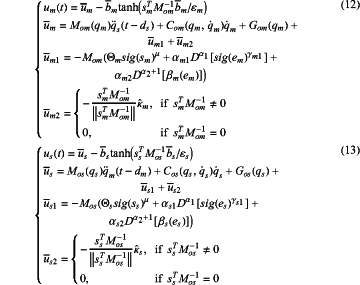| CPC B25J 9/1689 (2013.01) [B25J 3/00 (2013.01); B25J 9/163 (2013.01)] | 3 Claims |

|
1. A fractional order sliding mode synchronous control method for a teleoperation system based on an event trigger mechanism, characterized in that, the method comprises steps of:
S1, establishing a dynamic model for the teleoperation system by considering external disturbance and parameter uncertainty, wherein the dynamic model is:
Mm(qm)qm+Cm(qm,qm)qm+Gm(qm)+Bm(qm)=τm+Fh
Ms(qs)qs+Cs(qs,qs)qs+Gs(qs)+Bs(qs)=τs+Fe (1)
in which, qi, qi, q1∈Rn respectively represent a generalized displacement, a speed and an acceleration of n joints of the robot; Mi(qi) represents a positive definite inertial matrix of the system; Ci(qi, qi) represents a matrix of Coriolis forces and centrifugal forces of the system; Gi(qi) represents a gravity moment of the system; Fh, Fe∈Rn respectively represent an external force applied by an operator and an external force applied by the environment; τi∈Rn represents a generalized input moment; Bi(qi)∈Rn represents a unknown external interference; i=m, s, m represents a master robot, s represents a slave robot;
Mi(qi), Ci(qi,qi) and Gi(qi) have a relationship of:
 in which, Moi(qi) represents a nominal value of the positive definite inertia matrix of the system; Coi(qi,qi) represents a nominal value of the matrix of Coriolis forces and centrifugal forces of the system; Goi(qi) represents a nominal value of the gravity moment of the system; ΔMi(qi) represents parameter change of the positive definite inertia matrix of the system; ΔCi(qi,qi) represents parameter change of the matrix of Coriolis forces and centrifugal forces of the system; ΔGi(qi) represents parameter change of the gravity moment of the system;
at the same time, Bi(qi) satisfies:
∥Bi(qi)∥≤Bi (3)
in which, Bi represents an unknown positive number;
then,
 in which, Pm(qm,qm,qm) represents a parameter matrix of the master robot; Ps(qs,qs,qs) represents a parameter matrix of the slave robot;
Pm(qm,qm,qm) and Ps(qs,qs,qs) are bounded and satisfies:
∥Pm(qm,qm,qm)∥≤κm
∥Pm(qm,qm,qm)∥≤κs (5)
in which, κm represents an upper limit of ∥Pm(qm,qm,qm)∥, κm=b0m+b1m∥qm∥+b2m∥qm∥2; κs represents an upper limit of ∥Ps(qs,qs,qs)∥, κs=b0s+b1s∥qs∥+b2s∥qs∥2; b0i, b1i, b2i(i=m, s) is a positive constant;
accordingly, equation (1) for the system is re-represented as:
 S2, selecting the master robot and the slave robot, interactively constructing the teleoperation system through a communication network, measuring respectively mass and length information of a master robot connecting rod and a slave robot connecting rod and real-time robot position information of the master robot connecting rod and the slave robot connecting rod, and determining system parameters of the dynamic model;
S3, designing a sliding mode surface equation of a fractional order nonsingular rapid terminal by using position tracking errors of the master robot and the slave robot and Riemann-Liouville fractional order calculus;
S4, setting a trigger event condition of information interaction between the master robot and the slave robot, designing a self-adaptive fractional order nonsingular rapid terminal sliding mode controller which can compensate measurement errors and eliminate the influence of system uncertainty based on the sliding mode, enabling the controller to avoid the Zeno phenomenon, performing stability analysis, proving the boundedness of a closed-loop state signal of the system, enabling the slave robot to track the motion of the master robot within a limited time, and realizing synchronous control of the teleoperation system;
in step S4, the trigger event condition is:
 in which, zi(t) represents a measurement error, zi(t)=[zi1, zi2, . . . , zin]T and zi(t)=ui(t)−τi(t); τi(t) represents a generalized input moment of the teleoperation system, τi(t)=[τi1, τi2, . . . , τin]T; bi represents a positive definite matrix, bi(t)=[bi1, bi2, . . . , bin]T ∈Rn; ui(t) represents actual controller under event trigger mechanism, ui(t)=[ui1, ui2, . . . , uin]T; tki, k∈z+ represents controller update time;
in a period of time ti∈[tki,tk+1t), the control signal remains constant until ti=tk+1i, minimum internal time of the mentioned event trigger mechanism is strictly greater than 0, which eliminates occurrence of the Zeno behavior;
based on the designed sliding mode, the actual controller is chosen as:
τi(t)=ui(t)−λi(t)bi (11)
in which, λi(t) represents a continuous time-varying parameter satisfying conditions λi(tki)=0,λi(tk+1i)=±1 and |λi(t)|≤1, ∀t∈[tki,tk+1i;
the sliding mode controller of the self-adaptive fractional order nonsingular rapid terminal is designed as:
 in which, bm represents a positive definite matrix, bm=[bm1, bm2, . . . , bmn]T and satisfies the constant bmj>bmj(j=1, 2, . . . , n); bs represents a positive definite matrix, bs=[bs1, bs2, . . . , bsn]T and satisfies the constant bsj>bsj(j=1, 2, . . . , n); εm, εs represents a positive constant to be designed; Θi represents a positive definite diagonal matrix, Θi=diag[θi1, θi2, . . . , θin] and satisfies the constant θij>0(j=1, 2, . . . , n); μ represents a positive constant to be designed and satisfies μ∈(0,1); κm represents an estimated value of an upper bound of ∥Pm(qm, qn, qm)∥, κm=b0m+b1m∥+b2m∥qm∥2; κs represents an estimated value of an upper bound of ∥Ps(qs, qs, qs)∥, κs=b0s+b1s∥+b2s∥qs∥2; variables b0i, b1i, b2i representing estimated values of parameters b0i, b1i, b2i, respectively;
the self-adaptation law is designed as:
{dot over (b)}0i=Λ0i∥siTMoi−1∥
{dot over (b)}1i=Λ1i∥siTMoi−1∥∥qi∥ (14)
{dot over (b)}2i=Λ2i∥siTMoi−1∥∥qi∥2
in which, Λ0i, Λ1i, Λ2i represents positive constants;
a Lyapunov function is selected as:
 in which, V represents a Lyapunov function; V1 represents a first Lyapunov function, V2 represents a second Lyapunov function, bji=bji−bji represents a self-adaptive estimation error, j=1, 2, . . . , n;
limited time stable operation of the nonlinear uncertain teleoperation system is ensured through stability analysis.
|